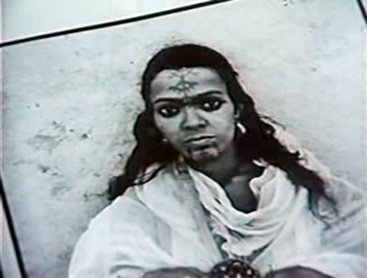
Born in 1944 Czechoslovakia
Died in 2014

1988
16mm film transferred to digital Beta, color, sound
durée : 75'
Year of Purchase: 2009
The film opens with the rolling of the sea artificially simulated by a wave machine. This is a judicious metaphor for the subject to be tackled next, but also for Harun Farocki’s artistic economy: the usage of the documentary as an analogy for the flux of thought, following a movement that is free and disorderly, flexible and determined, and cyclical rather than linear. Dynamic, driving thought that possesses the energy of water.
It was in the mid-1960s that the German artist began shooting films motivated by his political engagement and based on subtle reflection on the image. Starting with a few formal motifs (workers leaving a factory, images of prisons, the shape of roads), the artist has developed a critical vision of dominant structures of our society. His critique operates on the mode of dialectical demonstration, playing formally on the constant going back-and-forth between the (trenchant) commentary and the image; he opts for a rather restrained form to satisfy a didactic, rather than spectacular, ambition. In his approach, Farocki follows one obsession: to show how war wedges itself into the structures of society, and how its objects and methods intersect with economic, technical, technological, ethical, and industrial flux, establishing an analogy between the administrative and the military logic around the same structural models, the same semantics, and the same issues. By turns commented images or illustrated arguments, Farocki’s film-objects utilize a Godard-like cinematographic grammar for political and denunciatory goals, thus setting him apart as an artist.
In this context, Images of the World and the Inscription of War are a reflection on progressive mechanization of the modern gaze, which is due to the rise of photography, and more specifically aerial photography. Starting from the premise that the latter originated in remote observation which made it unnecessary to be present at the place of the event (since Meydenbauer, the pioneer of photogrammetry in the 19th century), Farocki develops and analyzes the consequences of this ballistic approach to the gaze in terms of renunciation of experience, camouflage . . . and, in the end, new blindness. Following the path of thinking at work, the film evokes portraits of Algerian women “unveiled” in order to be photographed by the colonial administration; images of gas chambers taken from Allied airplanes; and in between, shots of robots, flight simulators, and nude models posing in an art class. Farocki thus denounces the contradictions of a technological “supra-vision” which is at once exact and overbearing. Military photography, derived from the techniques of spatial projection developed in Renaissance art, transforms representation into coded reports, statistics elucidating a computational or numerical, and therefore virtual, relation to knowledge. The result is a plethoric production of images that no one watches or analyzes, and which proves to be inoperative, like those Allied planes flying over Auschwitz without destroying it. Farocki critiques automatic, indifferent surveillance, revealing the void of a “pure military fiction” which is opposed to the real.
Just as Chris Marker’s films, Harun Farocki’s demonstration does not mete out a moral lesson, nor does it impose an openly accusatory commentary. Rather, the film maker bets on the cognitive and critical power of the montage itself, on the juxtaposition of images and facts as on a form of discursive intelligence and efficiency.
Guillaume Désanges